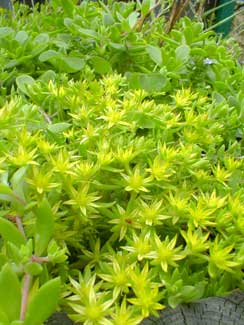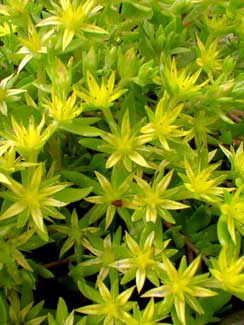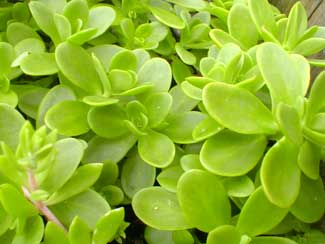
Graveyard Moss; aka:
Stringy Stonecrop or Star Sedum
"Yellow with stonecrop
the moss-mounds are yellow."
-George Meredith
(1828-1909)
(1828-1909)
The main succulent leaves of Sedum sarmentosum, an Asian stonecrop, are thick & roundish, but it flowers mainly on "strings" or creeping branches of thinner almost needle-like pointed leaves. The flowering stems of leaves in many cases creep away from the main plant or dangle over the edge of a container, in other cases rest on top of the rounder main leaves.
This feature lends it the common name Stringy or Trailing Stonecrop, while the blooms lend it the names Yellow Moss, Star Sedum, or Gold Moss. When its flowers are faded, I remove these thinner leaves along with the spent flowers for a tidier stonecrop, as in the third photo.
 I planted this in a large wooden bucket (a halved whiskey barrel about half the size of a cut-down wine barrel). It has proven more than commonly drought hardy even for a sedum, suffering no damage when I've forgotten to get water out to it for weeks on end. Nor is it damaged in winter by chills & long periods of rainfall.
I planted this in a large wooden bucket (a halved whiskey barrel about half the size of a cut-down wine barrel). It has proven more than commonly drought hardy even for a sedum, suffering no damage when I've forgotten to get water out to it for weeks on end. Nor is it damaged in winter by chills & long periods of rainfall.It is one of the toughest sedums & will spread to wherever a piece of it falls or is tossed. It can sometimes be a bit pesky in its rapid spread & has escaped cultivation to naturalize throughout the eastern half of the United States, which is partly why I've kept it in a barrel. Its common name Graveyard Moss arose from it having spread willynilly through many a cemetery. It's one of the few stonecrops that might be able to hold its own in a competition with ice plants for rapid groundcover on a droughty roadside.
 The spring & early summer star-flowers are yellow or yellow-green. Sometimes it's so golden-bright it seems to shine, but the flowers are not invarably showy against leaves that can be somewhat yellowish-green so that flowers & leaves don't have the strongest possible contrast.
The spring & early summer star-flowers are yellow or yellow-green. Sometimes it's so golden-bright it seems to shine, but the flowers are not invarably showy against leaves that can be somewhat yellowish-green so that flowers & leaves don't have the strongest possible contrast.Adaptable at least from Zones 4 to 8, with protection stretchable to zones 3 & 9. It likes full sun or just a little shade, in moist or dry well draining soil, very unfussy about soil type or condition. It grows on average four to six inches tall but can hump up higher, with virtually limitless spread.
As with most sedums, the leaves can be used as a substitute for sweet peppers either raw in salads or fried into relish. Their green-pepperiness keeps stonecrops from being too much browsed by deer or rabbits.
In China, Japan & Korea it is included among medicinal herbs & is available in commercially prepared extracts & powders with the name Chuipengcao or Chui pen cao. It is used as a general gastric & renal regulator. The plant has several flavonoids which may have legitimate medicinal value though beneficial outcomes are not well documented; & this sedum is a known source of herbal estrogen, so would probably interfer with the endocrine system of regular users.